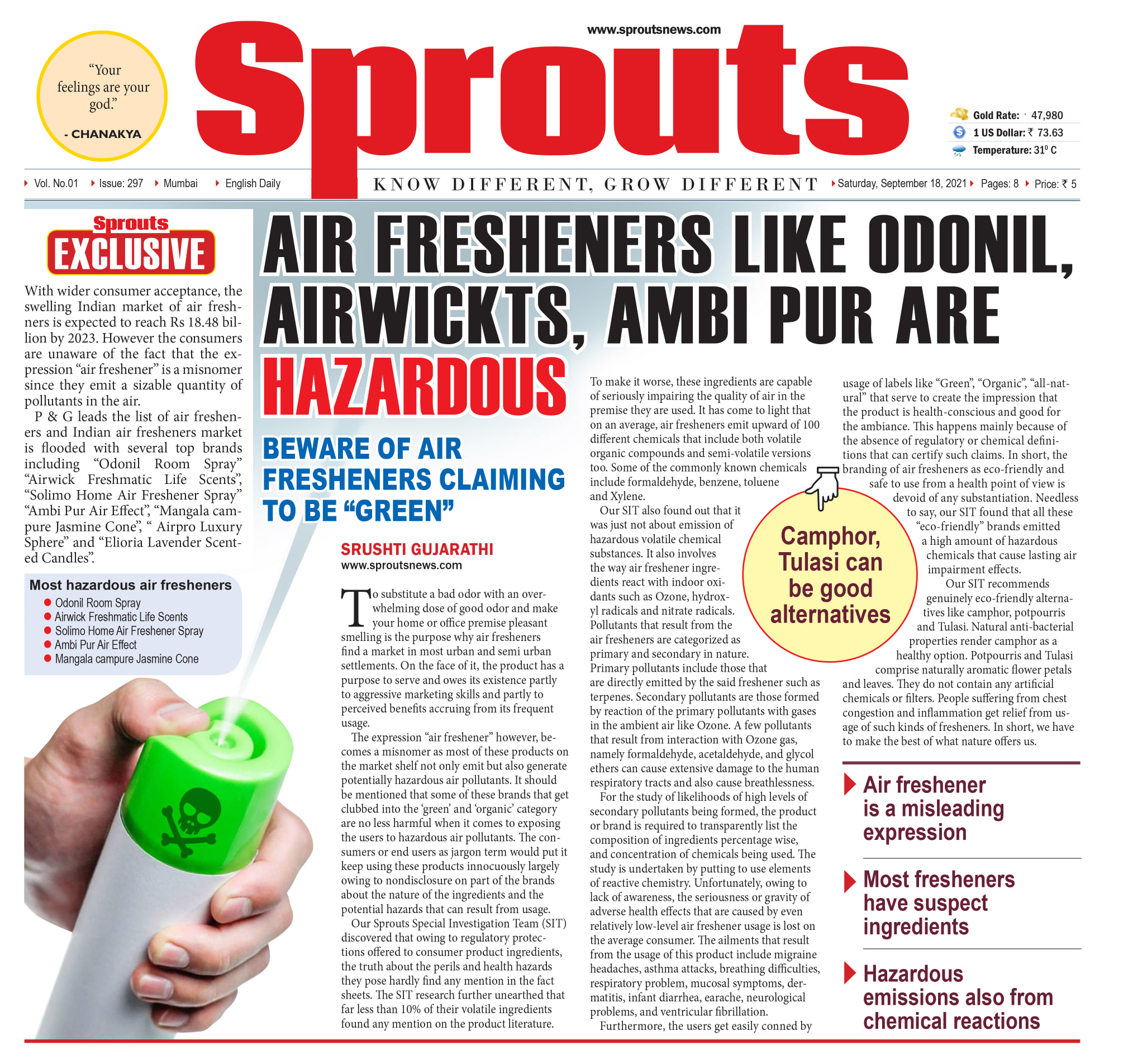
With wider consumer acceptance, the swelling Indian market of air fresheners is expected to reach Rs 18.48 billion by 2023. However the consumers are unaware of the fact that the expression “air freshener” is a misnomer since they emit a sizable quantity of pollutants in the air.
P & G leads the list of air fresheners and Indian air fresheners market is flooded with several top brands including “Odonil Room Spray” “Airwick Freshmatic Life Scents”, “Solimo Home Air Freshener Spray” “Ambi Pur Air Effect”, “Mangala campure Jasmine Cone”, “ Airpro Luxury Sphere” and “Elioria Lavender Scented Candles”.
To substitute a bad odor with an overwhelming dose of good odor and make your home or office premise pleasant smelling is the purpose why air fresheners find a market in most urban and semi urban settlements. On the face of it, the product has a purpose to serve and owes its existence partly to aggressive marketing skills and partly to perceived benefits accruing from its frequent usage.
The expression “air freshener” however, becomes a misnomer as most of these products on the market shelf not only emit but also generate potentially hazardous air pollutants. It should be mentioned that some of these brands that get clubbed into the ‘green’ and ‘organic’ category are no less harmful when it comes to exposing the users to hazardous air pollutants. The consumers or end users as jargon term would put it keep using these products innocuously largely owing to nondisclosure on part of the brands about the nature of the ingredients and the potential hazards that can result from usage.
Our Sprouts Special Investigation Team (SIT) discovered that owing to regulatory protections offered to consumer product ingredients, the truth about the perils and health hazards they pose hardly find any mention in the fact sheets. The SIT research further unearthed that far less than 10% of their volatile ingredients found any mention on the product literature.
To make it worse, these ingredients are capable of seriously impairing the quality of air in the premise they are used. It has come to light that on an average, air fresheners emit upward of 100 different chemicals that include both volatile organic compounds and semi-volatile versions too. Some of the commonly known chemicals include formaldehyde, benzene, toluene and Xylene.
Our SIT also found out that it was just not about emission of hazardous volatile chemical substances. It also involves the way air freshener ingredients react with indoor oxidants such as Ozone, hydroxyl radicals and nitrate radicals. Pollutants that result from the air fresheners are categorized as primary and secondary in nature. Primary pollutants include those that are directly emitted by the said freshener such as terpenes. Secondary pollutants are those formed by reaction of the primary pollutants with gases in the ambient air like Ozone.
A few pollutants that result from interaction with Ozone gas, namely formaldehyde, acetaldehyde, and glycol ethers can cause extensive damage to the human respiratory tracts and also cause breathlessness.
For the study of likelihoods of high levels of secondary pollutants being formed, the product or brand is required to transparently list the composition of ingredients percentage wise, and concentration of chemicals being used. The study is undertaken by putting to use elements of reactive chemistry. Unfortunately, owing to lack of awareness, the seriousness or gravity of adverse health effects that are caused by even relatively low-level air freshener usage is lost on the average consumer. The ailments that result from the usage of this product include migraine headaches, asthma attacks, breathing difficulties, respiratory problem, mucosal symptoms, dermatitis, infant diarrhea, earache, neurological problems, and ventricular fibrillation.
Furthermore, the users get easily conned by usage of labels like “Green”, “Organic”, “all-natural” that serve to create the impression that the product is health-conscious and good for the ambiance. This happens mainly because of the absence of regulatory or chemical definitions that can certify such claims. In short, the branding of air fresheners as eco-friendly and safe to use from a health point of view is devoid of any substantiation. Needless to say, our SIT found that all these “eco-friendly” brands emitted a high amount of hazardous chemicals that cause lasting air impairment effects.
Our SIT recommends genuinely eco-friendly alternatives like camphor, potpourris and Tulasi. Natural anti-bacterial properties render camphor as a healthy option. Potpourris and Tulasi comprise naturally aromatic flower petals and leaves. They do not contain any artificial chemicals or filters. People suffering from chest congestion and inflammation get relief from usage of such kinds of fresheners. In short, we have to make the best of what nature offers us.
[inhype_block type=”postsgrid7″ block_title=”Also Read” block_posts_type=”latest” block_categories=”” block_posts_limit=”4″ block_posts_loadmore=”no” block_posts_offset=”0″]











